Report on Fire Danger in our National Forests: Causes, Costs, Prevention Measures
Prepared by:
Nancy Freeman
P. O. Box 934
Green Valley, AZ 85614
Date: May 22, 2014
There are no fire hydrants in the National Forests in the Southwest, but the Forest Service is aggressively permitting industrial projects that have proved to enhance fire danger in the forests while lowering the water levels to endanger the health of the trees. At the present time, forest fire danger heightens as drought continues in the Southwest with the traditional high winds of spring and record high temperatures that are augmenting the dry conditions. Today (5-20-14) where I live in Green Valley, AZ, near the Coronado National Forest , the temperature is 95° and the wind speed is 22 mph with gusts up to 30 mph. According to the National Weather Bureau we have had only 0.6 inches of rain in 2014. Even so, I am unable to find any fire danger alerts on the Coronado National Forest website.
The major causes of forest fires are nature, lightning, and human: campfires and cigarettes; however, faulty electrical wiring, sparks from vehicles and sparks from welding machinery are common, plus flames produced by hazardous waste spills from truck accidents on public lands. An overheated BLM vehicle caused the Chariot Fire that burned 7,000 acres in the San Diego Forest in July 2013. http://wildfiretoday.com/2013/07/08/california-chariot-fire]
Since industrial projects, especially mining operations, bring all but one of these “human cause” risks to the National Forest, it is clear that an increase of mining industry in our National Forests increases the fire risk. We have two examples in the region I live in Arizona.
In May 2011, two mining companies caused fires in the Coronado National Forest with welding projects. At the time, the “Fire Danger” was at Level 1: campfires and cigarettes are prohibited; yet in both cases the miners were out-of-doors welding in May. May and June are the hottest, driest months in the Southwest, which forest fire data confirms. A further complication is that industrial sites are surrounded by 10 ft. high chain-link fences for security reasons, making it impossible for fire fighting equipment to enter multiple acres of National Forest public land, except at a main gate.
Considering there are 170 mining operations being permitted in 44 National Forests in the West [www.mining-law-reform.info/proposed-mining-projects.htm], the fire danger from industrial mining needs to be addressed. National Forest Service record of mining project on the National Forest: FSOperations Records.
The fire dangers of industrial mining in the National Forests have not been adequately addressed. The latest updated report by the Interagency Fire Center, clearly states that risk for fire danger must be taken into consideration for any activity in the National Forests:
Guiding Principles. . . .
No. 4. Sound risk management is a foundation for all fire management activities.Risks and uncertainties relating to fire management activities must be understood, analyzed, communicated, and managed as they relate to the cost of either doing or not doing an activity. Net gains to the public benefit will be an important component of decisions.
Source: Guidance for Implementation of Federal Wildland Fire Management Policy
http://www.nifc.gov/policies/policies_documents/GIFWFMP.pdf
The cost is too high to dismiss any risk of wildfires in the West. The Federal Government can no longer ignore the facts and figures. The government research for sound management has been done. The government reports for protection practices have been published.
The question is when will the sound management and practices recommended in these reports be implemented? We taxpayers want and deserve “responsibility” from our Federal agencies on this crucial problem, especially the Forest Service that manages the majority of the forested lands.
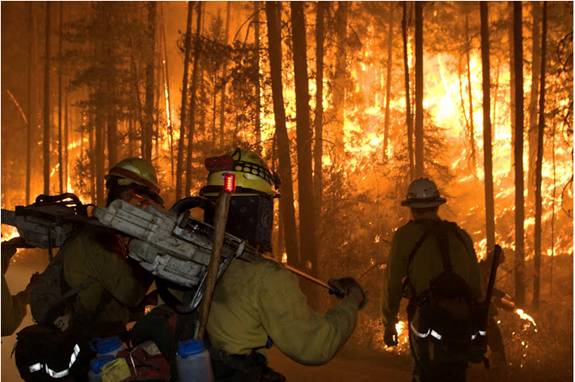
Forest Wildfire Fighters
This report will address the following issues:
• How much Forest do we lose to fire each year?
• Examples of forest fires caused by mining companies
• Where is water available to put out forest fires?
• Cost of putting out wildfires on public lands
• Cost to homeowners and insurance companies
• Loss to outdoor recreation economy
• WildFire Prevention Measures: Could the taxes be spent improving the situation?
• Dozens of reports accumulated for sane, sound, scientific action
How much Forest do we lose to fire each year?
With millions of acres of forest burned each year, is it wise to permit high fire risk projects in the National Forests?
Wildfires currently burning in Arizona, May 2014
Sat, 17 May 2014 14:36:00 -05:00 |
|
Thu, 15 May 2014 14:18:30 -05:00 |
|
Tue, 13 May 2014 16:41:16 -05:00 |
|
Tue, 13 May 2014 16:38:56 -05:00 |
|
Prescott National Forest Officials Report Walker Fire 100 Percent Contained |
|
Sat, 10 May 2014 21:58:55 GMT |
|
Thu, 08 May 2014 17:07:10 GMT |
|
Mon, 05 May 2014 22:48:12 GMT |
|
Mon, 05 May 2014 17:01:28 GMT |
|
Mon, 05 May 2014 16:35:21 GMT |
|
Redington Fire Burning in Rough Terrain on Coronado National Forest |
|
Source: Arizona's Emergency Information Network
http://www.wildlandfire.az.gov
The National Interagency Fire Center (NIFC) records wildfire data and statistics, both present and historic, on wildfires on U.S. public lands. Most of the data and graphs in reports from insurance business to environmental action groups come from the public land data on their informational site. The fire center, located in Boise, Idaho, is the nation's support center for wildland firefighting. Eight different Federal government agencies and organizations are part of NIFC. They also maintain a daily report of current fire incidents in all public lands for all states. [www.nifc.gov/nicc/sitreprt.pdf]
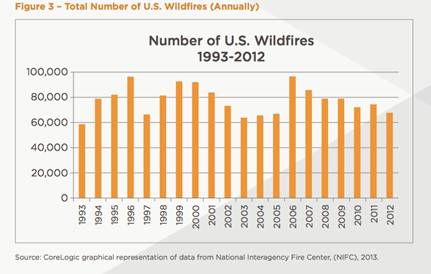
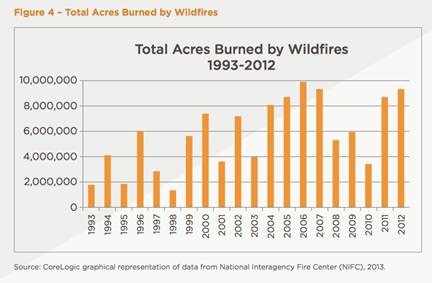
Examples of forest fires caused by mining companies in Coronado National Forest
In May of 2011, two wildfires occurred within 50 miles of Tucson, Arizona that were started by employees of two distinct mining companies. Apparently, in both cases, sparks from equipment started the fires although the Forest Service had issued a Level 1 alert.
Wildcat Fire, May 2011: A wildfire was started by an employee “grinding on equipment” with a power tool. The “Wildcat” Fire, named for the mining company, spread to the Patagonia Mountain section of the Coronado National Forest and burned some 400 acres and cost about $300,000 to put out. Apparently, the burned area is the same acreage that the Forest Service has authorized the mining company to drill on public land, 15 exploratory holes on up to 2,000 ft. deep to assay the silver content for a proposed mining project. Ike Isaacson, the mayor and chief of the volunteer fire department of the nearby town of Patagonia, stated it was a windy day.
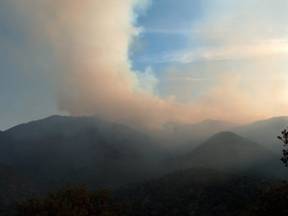
Wildcat Fire in Patagonia Mountains
Greaterville Fire, May 2011: an employee of Rosemont Copper started a wildfire in the Santa Rita area of the National Forest. From the information available, the welder was working by himself during one of the worst fire seasons in Arizona's history. The report from Rosemont Copper stated that welder was working on a broken bracket at a well site. The fire consumed approximately 2,200 acres before being extinguished. In this particular case, Rosemont Copper will be destroying up to 300,000 trees on National Forest land, so it apparently there will be nothing left of the forest to burn. [www.savethesantacruzaquifer.info/FS-summary-of-trees-to-destroy.pdf] While organizations are dedicated to planting trees all over the world, the Forest Service is permitting their permanent destruction. The land will never be available for “multiple use.”
As of May 1, 2014, (three years later) the Rosemont Copper has not paid the $500,000 accessed by the Forest Service for suppression of the fire. I have filed an FOIA for current information on the payment. The Wildcat Silver Mining Co. apparently paid the fine for the Wildcat Fire violation in 2013.
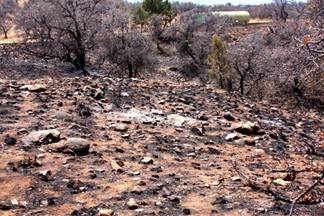
Burned out area with welded water tank in background
Where is water available to put out forest fires?
A big question is where will the water come from to put out forest fires in the National Forests in the face of widespread water depletion. Water has always been an issue in the dry Arizona historic mining regions. In the late 1800's, entrepreneurs packed in bags of water on burros to sell to the miners working placer deposits near Greaterville.
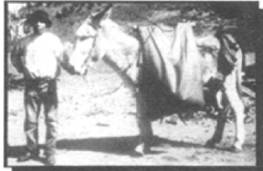
Transporting water to miners
Photo: Arizona Historic Society
The Forest Service does not create or maintain any water supplies, no holding tanks, no reservoirs, no wells; in short, no projects or plans to increase water supply on public lands. Since there are few lakes in the Southwest (except around Phoenix and Las Vegas), the Forest Service relies on others to come up with water supplies. Since cattle ranching arrived in the SW before the advent of National Forest system, ranches lands and small towns are scattered through and around the National Forests. In fact, almost 50% of the land in the Southwest is Federal land. Since settlers chose to homestead in areas with water supplies, the majority of the remaining public lands are dry and inaccessible landscapes.
Since the Federal Government owns about 50% of the land, planning for water supplies for fire suppression is an important duty. There is an ongoing debate on whether to suppress or let burn (as nature has always done to renew forests). However, the fact is humans have changed they landscape and they cause some 50% of the fires in inhabited areas. So the debate over human intervention hardly seems appropriate when in fact humans have already intervened.
Using Arizona as an example, when there is a fire the emergency call goes to a state dispatcher, who notifies fire stations of local towns, which then have to haul water meant to protect their townships and/or set up pump stations at any available ranch stock ponds to fill the fire truck tanks. Although the towns and ranchers (who have contracts with the fire districts) are reimbursed for the water used, they do lose water needed in their region for other purposes.
The wildfire dispatch system, Southwest Coordination Center (SWCC), is an incredible network that works very well to bring men, fire engines, and supplies to the emergency sites, but the problem of water supply is crucial in rural areas where forested public lands are more common and these are the areas with the biggest fires: More fuel, less water and manpower.
USGS has released a report: Ground-water depletion across the nation [http://pubs.usgs.gov/fs/fs-103-03/JBartolinoFS(2.13.04).pdf] Groundwater depletion is a major factor in the unhealthy condition of the trees in our forest, causing dry conditions that promote bark beetles and forest fires. The large quantities of water used to suppress forest fires is water taken out of the public water supply intended for other uses, such as ranching, food crops and domestic use.
Water is protected in National Forests and other Federal Public Lands. When the United States reserves public land for uses such as Indian reservations, military reservations, national parks, forest, or monuments, it also implicitly reserves sufficient water to satisfy the purposes of the federal entity, which would include maintaining water levels for sustaining of the trees, habitat and wildlife in the National Forests. This federal “reserved water rights” doctrine was established by the U.S. Supreme Court in Winters v. United States in 1908.
The Winters Doctrine was verified in 1999 by the Supreme Court of Arizona; 195 Ariz. 411;989 P.2d 739;1999 Ariz.
[www.g-a-l.info/AZAdjudication.htm]
The presiding judge, NOEL A. FIDEL documented in the OPINION two major issues:
Issue 4: Do federal reserved water rights extend to groundwater (underground water) that is not subject to prior appropriation under Arizona law?
Issue 5: Are federal reserved rights holders entitled to greater protection from groundwater pumping than are water users who hold only state law rights?
The conclusion is stated in P31 of the Opinion:
For the foregoing reasons, we hold that the trial court correctly determined that the federal reserved water rights doctrine applies not only to surface water but to groundwater. We decide this issue in the abstract at this time as a necessary step in determining the scope of interests to be encompassed by this adjudication. We do not, however, decide that any particular federal reservation, Indian or otherwise, has a reserved right to groundwater. A reserved right to groundwater may only be found where other waters are inadequate to accomplish the purpose of a reservation. To determine the purpose of a reservation and to determine the waters necessary to accomplish that purpose are inevitably fact-intensive inquiries that must be made on a reservation-by-reservation basis. See United States v. New Mexico , 438 U.S. at 700.
In Arizona, water is regulated only in certain populated areas. In spite of Judge Fidel's observations, mining and other industry remains effectively exempt from groundwater rules. Since National Forests are in rural areas there are no rules whatsoever. Case in point, Rosemont Copper in the Coronado NF, the company has ignored the well registration rules of their industrial-use well ID 55-207382 on private ranch property, surrounded by National Forest. The company is pumping thousands of gallons from the well, which is listed by ADWR “in violation” because the company has not complied with the simple rule of changing the registration from “domestic” to “industrial” use. This registration requires the company to file an annual report showing how much water has been pumped from the well that year. In any event, they continually pump water from the well, truck it across Forest Service land, and take it to their industrial site: www.youtube.com/watch?v=cGJJNbrl1Qg. On the video, the reality of the security fence/locked gate on industrial mining facilities that would prohibit access in case of fire is also illustrated.
The environmental director of Rosemont Copper stated in 2008 that their wells on one of their sites for industrial operations were going dry. “Our wells at Hidden Valley Ranch.... we have two or three wells there. Some of them were just drilled last year. Some of those went dry last year.” (video: www.youtube.com/watch?v=spJ4nA7ecVk)
As has been shown in two recent cases on the Coronado, industrial operations in the forest increases the risk of forest fires, and the pumping of water from the forests and the region compromises water supplies for suppression of fires. Further, as mining continues, the mining pit (a half-mile deep) causes a sump in the groundwater throughout the region because the pits have to be continually pumped dry for dynamiting and ore and waste rock removal by haul trucks. Map of predicted water depletion for the Rosemont Copper project in the Coronado National Forest: Map of Rosemont drawdown on regional wells.
In addition to the mandated protection of groundwater in Federal lands, the Forest Service regularly publishes reports on their priority of watershed management to provide water supply and clean water [www.celebrate-earth.com/national-forests-and-water/], while they are neglecting to give top priority to fire prevention methods since forest fires are a major pollutant of water surface sources.
Secretary of Agriculture Vilsack and Forest Service Chief Tidwell continue to speak of forest and watershed restoration, instead of protection of watersheds, even though a Forest Service report states that once a watershed is destroyed:
“Even with aggressive management, that momentum [of current damage rate] will not be overcome within the next 100 years under projected funding. Progress toward forest health restoration can be expected to proceed very slowly…. These findings suggest that it will not be feasible to restore all degraded areas.”
Source: Water and the Forest Service
www.stream.fs.fed.us/publications/PDFs/Water_and_FS.pdf
Cost of putting out wildfires on public lands
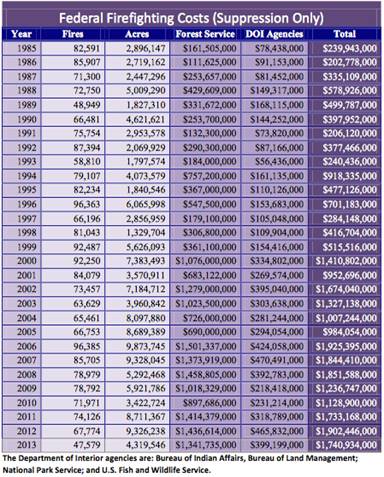
Source: National Interagency Fire Center
www.nifc.gov/fireInfo/fireInfo_documents/SuppCosts.pdf
The combined total of the 2013 budgets of Federal Forest Service and Department of Interior (BLM, Park Service, BIA and Fish and Wildlife) is three billion dollars. This figure does not include the Federal FEMA grants received in emergency situations.
Federal Budgets for wildfire management and suppression:
Cost to Federal taxpayers: The combined total of the 2013 budgets of Federal Forest Service and Department of Interior (BLM, Park Service, BIA and Fish and Wildlife) is three billion dollars. This figure does not include the Federal FEMA grants received in emergency situations.
Federal Budgets for wildfire management and suppression:
Department of Interior budget:
Department of Interior Budget for Wildfire Activities (2013)
[Dollars in thousands]

Source: Department of Interior Report: Budget Justifications and Performance Information: Fiscal Year 2013; Wildland Fire Management (Page 72)
www.doi.gov/budget/appropriations/2013/upload/FY2013_WFM_Greenbook.pdf
Forest Service budget:
In the 2014 budget, 42.7% of the Forest Service budget of $5.5 billion goes for wildfire suppression.
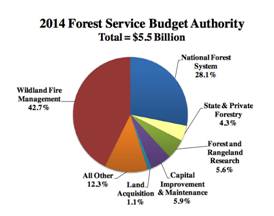
Forest Service Budget for Wildfire Activities (2014)
[Dollars in Millions]
![]()

Source: Forest Service Report: Budget Summary and Annual Performance Plan: FY2014 (Page 72) [www.obpa.usda.gov/budsum/FY14budsum.pdf]
FEMA Grants for Fire Suppression:
FIREFIGHTER FUNDING AND APPLICATION SCHEDULE
FY 2014 Assistance to Firefighter Grant (AFG) Funding?An appropriation of $680 million has been approved for FY 2014
• $340 million will support Fire and EMS Operations and Safety Grants, Firefighting and Emergency Vehicle Grants and Fire Prevention and Safety Grants
• $340 million will support SAFER grants
FY 2013 Assistance to Firefighter Grant (AFG) Funding?An appropriation of $640 million has been approved for FY 2013
• $320.3 million will support Fire and EMS Operations and Safety Grants, Firefighting and Emergency Vehicle Grants and Fire Prevention and Safety Grants
• $320.3 million will support SAFER grants
Source: www.fema.gov/welcome-assistance-firefighters-grant-program
Mary Jo Pitzl of the Arizona Republic has written such an informative, data-filled article on the cost of fighting fires, based on Arizona's historical Wallow fire that it merits reading, as it applies to all wildfire management.
Busy Arizona wildfire season burns through state's budget
by Mary Jo Pitzl - Jul. 20, 2011 12:00 AM
The Arizona Republic
www.azcentral.com/news/articles/2011/07/20/20110720arizona-fire-budget-costs.html#ixzz31KyXaAPU
The fires that engulfed large tracts of Arizona forests and grasslands this year also burned through the state's fire-suppression budget.
The state used all of the nearly $5 million in its budget to fight the fires that ripped across Arizona in May and June, and it may have to dip into the fiscal 2012 budget to help cover final costs, State Forester Scott Hunt said.
But the tab would have been much higher if not for federal grants, which will cover 75 percent of the state's costs.Grants are intended to prevent a fire from raging out of control and can't be awarded once a blaze has engulfed an area, according to guidelines set by the Federal Emergency Management Agency. That makes early notification key, and FEMA can respond in a matter of hours.
A grant covers costs such as dispatching fire engines and feeding fire crews. Hunt said it can cost $2,000 to $3,000 a day to send a truck with three firefighters to a blaze.
At the height of last month's fires, 150 trucks were working the Wallow, Horseshoe Two and Monument fires combined, he said.
Meals, at 8,000 to 9,000 calories a day, cost about $50 a day per firefighter, he said. The Wallow Fire alone had more than 4,000 firefighters battling it during its height.
When fires break out, agencies rush to respond and later sort out who ultimately pays for what.
But the division lines are clear: The federal government pays for fires on federal land, and the state is responsible for any fires on 22 million acres of state trust land and unincorporated private land.
Most of this summer's big fires burned on federal land. But the flames did cross over into state territory, such as when the Wallow Fire threatened land and properties in Alpine, Eagar and Nutrioso.
The state has an agreement with those communities to share firefighting costs.
The state has 200 such cost-sharing agreements with local governments to maximize firefighting resources and avoid duplication, Hunt said.
Local governments may pay for operating emergency centers and stepping up patrols to ensure that evacuated areas are protected against criminals while the state pays for more of the direct costs of battling the wildfires.
Cost-sharing figures are still being worked out, Hunt said, which makes it impossible to give a precise figure for the state's costs this fire season.
When the fires were at their height, Democrats in the state Legislature noted the state's fire-suppression budget had been a victim of budget reductions, with nearly $250,000 cut from the fiscal 2011 budget and $300,000 from the budget that took effect July 1.
Total state spending cuts amounted to $2.4 billion during that span to balance the budget.
But Hunt said the firefighting dollars were buoyed by the fact that nearly $2 million left over from the 2009-10 budget rolled into the next year, giving his office nearly $5 million to use this year.
Costs to homeowners and insurance companies
CoreLogic compiled a case study on the Black Forest wildfire in Colorado, June 2013. Over the course of 10 days, the fire burned across 14,280 acres and caused the death of two people. Estimate of cost of firefighting was $9 million while some 486 structures were destroyed, with more than 3,600 insurance claims filed for a total damage amount of $292 million.
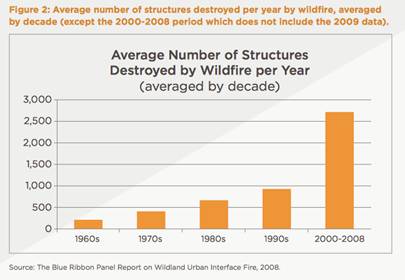
Page 7: CoreLogic: Wildfire Hazard Risk Report: Residential
Wildfire Exposure Estimates for the Western United States .
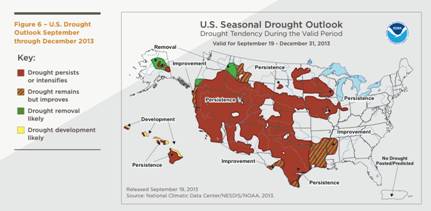
Page 14: CoreLogic: Wildfire Hazard Risk Report: Residential Wildfire
Exposure Estimates for the Western United States.
Residential loss estimates: According to the 2013 CoreLogic wildfire analysis, there are 1,262,022 residential properties in the western U.S. that are currently located in High or Very High wildfire-risk categories, valued at more than $189 billion. In the Very High risk category alone, there are just over 268,000 residences valued at more than $41 billion.
Information from CoreLogic® : Wildfire Hazard Risk Report:
Residential Wildfire Exposure Estimates for the Western United States 2013
Authors: Howard Botts, Ph.D. Thomas Jeffery, Ph.D. Steven Kolk, ACAS Sheila McCabe, Bryan Stueck, Logan Suhr
www.corelogic.com/research/wildfire-risk-report/2013-wildfire-hazard-risk-report.pdf
Loss to outdoor recreation economy
Outdoor recreation is an economic powerhouse in the United States, each year
- 6.1 million American jobs
- $646.0 billion in outdoor recreation spending each year
- $ 39.9 billion in federal tax revenue
- $ 39.7 billion in state/local tax
Total: $725.6 billion
Source: Outdoor Industries Association
[ http://outdoorindustry.org/pdf/OIA_OutdoorRecEconomyReport2012.pdf ]
Fish and Wildlife income from hunting and fishing licenses:
Fish (2011): $637,650,000 (28 million fishers at $23 average cost)
Hunter (2011): $790,018,000 (14.6 million hunters at $54 average cost)
Source: Fish and Wildlife www.fws.gov
The fact is that forest fire suppression is draining water resources in the dry West. The loss of water supplies intended for stock, recreation and domestic use is not accounted for in any study.
Water loss due to mining industry and suppression of fires is also an unmeasured amount. It is impossible to find an estimate of the amount of water used to suppress a forest wildfire. However, we do know the surrounding lakes, ponds, and local rural fire district supplies are depleted. However, we do know the amount of water used in mining operations. Freeport McMoran Sierrita copper mine in Green Valley (a local mine the size of the proposed Rosemont mine), uses 27,110 acre feet or nearly 9 billion gallons of water (acre foot = 325,851 gallons).
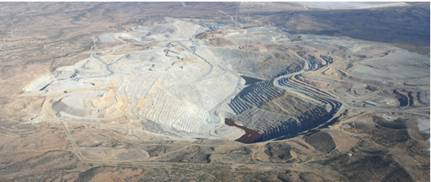
Typical mining operation in the West
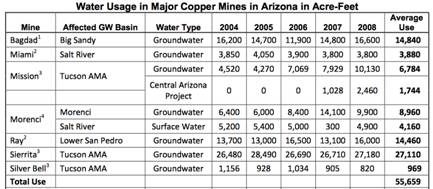
The loss of forests with their aesthetic and scenic beauty, wildlife, and wildlife habitat is difficult to place a dollar value on. The loss of recreational revenue to the Forest Service, and other agencies, due to fire damage has not been estimated. Eighteen months after the Wallow fire, many areas within the perimeter continue to present significant public safety hazards primarily associated with dead (falling) trees and flash flood impacts. The amount and level of public access provided is largely dictated by these public safety concerns and liabilities.
The loss of animals in wildfires is also unknown number but it is believed that most animals actually escape the fire. Surveys are seldom undertaken to determine how many animals die in wildfires or where they can find food and habitat. Fish and their habitat are very susceptible to intense flooding, increased erosion, and slurries of ash that can follow a wildfire during significant precipitation events.
Federal Liability: When the industrial operations, such as mining operations, do cause a wildfire, will the surrounding homeowners (who built homes on private land long before a mining project was proposed) have legal standing to collect damages from the Forest Service, if their homes are damaged or destroyed by fire? What is the Federal liability when the Forest Service is continually creating residential areas in harm's way with their land swap program?
Wildfire Prevention: Could the money be spent improving the situation?
As shown, suppressing forest fires is a multi-million dollar endeavor. The number and damage of forest fires escalates every year. The cost of suppressing fires escalates every year. Isn't it time to do something different to improve the situation? Where is the best place to put taxpayers' money? History has shown us that nothing will improve until the system improves.
There are three factors for the spread of a fire:
• Weather (heat)—we can't change
• Inaccessibility due to landscape irregularities—we can't change
• Fuel—we can do something here.
The author of this report had the unfortunate, but informative, experience of spending the summer in a cabin on Lake McDonald in Glacier National Park in 2003 during that historic fire season. Anyone who has ever built a campfire knows that the kindling and small branches only burn for a short time, but give out tremendous heat. On the other hand, large logs are often difficult to catch on fire and can smolder for hours. I was located on the south side of the lake, where I witnessed tall, mature pines on the north side of the lake, literally going up in flames-- exploding with a sound like a cannon ball— because of the heavy load of light fuel caused so much heat for this phenomenon. It was reported in the Wallow Fire the heat levels reached 2000 degrees and literally baked large mature trees to death.
An analysis of the Wallow Fire, the biggest fire in Arizona's history, in 2011 illustrated that the forest protection management on Native American lands did make a difference. Jonathan Brooks, tribal forest manager for the White Mountain Apache Tribe, said sound forest-management strategies helped check the wildfire on the Nations' lands.
Brooks explained that for decades, the tribe has cleared young trees, logged larger trees and burned underbrush to replicate the natural burn-and-growth cycle of the Ponderosa pine forest. Therefore, the firefighters were able to create a backfire in the Nation's to deprive the approaching Wallow Fire of fuel.
“Had this area not been thinned, logged, prescribe-burned, we wouldn't have been able to do a burnout operation here – so the fire would've been able to come through here unchecked,” explained Brooks.
A Bureau of Indian Affairs report that analyzed the Wallow Fire's impact on tribal lands confirms Brooks' assessment. Reports also show that the Wallow Fire killed fewer trees on the Fort Apache and San Carlos Apache reservations because it burned less intensely.
[ http://frontrangeroundtable.org/uploads/Wallow_Fire_Fuel_Treatments_Report_BIA.pdf ]
In May 2011, the National Forest Service published a report: Simulating fuel treatment effects in dry forests of the western United States: testing the principles of a fire-safe forest by Morris C. Johnson, Maureen C. Kennedy, and David L. Peterson [ http://www.fs.fed.us/pnw/pubs/journals/pnw_2011_johnson001.pdf ]
Effectiveness of fuel treatments in the West depends on thinning intensity : Simulation study of more than 45,000 forest stands provides scientific basis for fuel reduction guidelines
WASHINGTON , Aug. 1, 2011–In the largest ever study of fuel treatment effectiveness, U.S. Forest Service researchers have found that intense thinning treatments that leave between 50 and 100 trees per acre are the most effective in reducing the probability of crown fires in the dry forests of the western United States.
The study, the results of which are published in a recent issue of the Canadian Journal of Forest Research, provides a scientific basis for establishing quantitative guidelines for reducing stand densities and surface fuels. The total number of optimal trees per acre on any given forest will depend on species, terrain and other factors.
“This study proves once again that an ounce of prevention equals a pound of cure,” said U.S. Forest Service Chief Tom Tidwell. “Thinning dense forests reduces the impacts of the catastrophic wildfires we've already seen this year and expect to see more and more of in the future. This work helps protect communities, provides jobs and promotes overall better forest health.”
Decades of excluding fire in the Western states have resulted in densely packed stands and a buildup of forest-floor fuels in many dry forests, which can lead to large, continuous crown fires when wildfires do occur. Crown fires are of particular concern to managers because they are challenging to suppress and are capable of causing widespread mortality in stands.
Note: The author of this report did contact an author of the “ Effectiveness of fuel treatments in the West depends on thinning intensity” http://www.fs.fed.us/news/2011/releases/08/thinning.shtml report to inquire what actions had been taken as a result of the report, but he was not allowed to speak to a citizen on the subject.
Best technology to remove the fuel
Traditionally, prescribed burns have been the method of clearing underbrush. This method produces two complaints:
1) Residents complain of air pollution: The author of this report had the honor of living on a small ranch surrounded by the Sam Houston National Forest for a year. The Foresters did accomplish small prescribed burns. We residents on small homesteads that existed before the creation of the Forest Service endured the small amount of smoke because we knew that it was less impact than a full-blown forest fire. Small area burns can be a useful tool for forest management, but require manpower. A fire prevention educational program for residents is essential for cooperation with the Forest Service to protect their properties.
2) Conservationists object to removal of endangered species and wildlife habitat: It is true that prescribed burns do remove plants and thickets that wildlife use for forage and protection. It is also true that fire cannot discriminate between unwanted invasive species and endangered species. I found an unusual “Jack in the Pulpit” flower on the property I lived on in the Sam Houston NF that I have never been able to find in any wildflower reference book.
I have researched the possibilities. Large mechanical mulching tractors can be used to clear thick underbrush and small trees. Reducing the number of trees in a given area increases the amount of water, nutrients, and light available for other trees, increasing their vigor and ability to withstand attack of bark beetles.
When I lived in Sedona, a native cedar tree in your yard was turning brown. We called the County Agent and he told us, “It's a bark beetle attack. They only attack stressed trees. Water it well for the next couple of months.” We watered it and it is alive and well 25 years later.
Not possible practice in a forest setting, but removal smaller trees and other desirable plants does lessen the competition for water and nutrients. An advantage of using mulchers for thinning is they put a bed of mulch around the trees that helps hold in the moisture.
Also, mulching has the advantage that it can clear swaths through the forests that enhance wildlife movement, access to remote areas, and also provide firebreaks—in the case of a wildfire. Since a person maneuvers the machine, it is possible to select areas of invasive species for clearing and mulching, and avoid areas of endangered species. With the large, most productive mulchers, it is possible to clear and mulch 30 acres per day of small trees and underbrush—depending on the density.
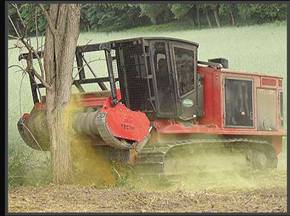
Top-production FTX600 Mulcher creating a fire line
These large tractor-like machines can create mulched fire lines that can stop ground fires. When fire hits these barriers of mulch, only the top of the mulch is exposed and turns into smoldering ash. There is no Oxygen on the lower layers of mulch, so they do not burn. These barriers also create a cover for erosion prevention. Therefore, when the floods that follow forest fires occur there is not the runoff of silt and exposed dirt to streams and other water sources. This is a big advantage over bulldozers that push everything out of the way, uproot tree stumps and remove everything down to dirt. The debris produces runoff to streams and water sources, and requires remediation of water and landscape to clean up the downed tress and stumps.
Dozens of reports accumulated for sane, sound, scientific action
1) The Four Forest Restoration Initiative (July 2011)
http://www.fs.usda.gov/main/4fri/timeline
http://fourforestrestorationinitiative.net/documents.html
2) Simulating fuel treatment effects in dry forests of the western United States : testing the principles of a fire-safe forest (May 2011) by Morris C. Johnson, Maureen C. Kennedy, and David L. Peterson
http://www.fs.fed.us/pnw/pubs/journals/pnw_2011_johnson001.pdf
3) Four Threats to the Health of the Nation's Forests and Grasslands
Healthy forests make for a healthy nation: In the 21st century, the nation's forests and grasslands face four threats. Forest Service Chief Dale Bosworth names them as: (a) fire and fuels, (b) invasive species, (c) loss of open space, and (d) unmanaged recreation.
http://www.fs.fed.us/projects/four-threats
4) Wallow Fire Fuel Treatment Effectiveness on the Fort Apache Indian Reservation
Wildland Fire Lessons Learned Center maintains a repository of relevant documents and studies on wildfires. It is national, interagency, federally funded organization with interagency staffing. The LLC's primary goal continues to be striving to improve safe work performance and organizational learning for all wildland firefighters.
5) WILDLAND FIRES: 2014 AND 2013 WILDFIRES
http://www.iii.org/facts_statistics/wildfires.html
6) Wildfire, Wildlands, and People: Understanding and Preparing for Wildfire in the Wildland-Urban Interface
http://www.fs.fed.us/openspace/fote/reports/GTR-299.pdf
7) Archive of Fire and Environmental Research Application Team
http://www.fs.fed.us/pnw/fera/research/index.shtml
8) Climate Change and Wildfires: What's the Connection?
http://www.globalchange.gov/news/climate-change-and-wildfires-what's-connection
9) Budget Justifications and Performance Information: Fiscal Year 2013; Wildland Fire Management
This extensive report contains much relevant information, not only about fire danger in the Southwest, but also the increasing danger in the Northwest due to the changing landscape.
http://www.doi.gov/budget/appropriations/2013/upload/FY2013_WFM_Greenbook.pdf
10) National Interagency Fire Center has more reports and statistics that you can read in a lifetime!
http://www.nifc.gov/fireInfo/fireInfo_statistics.html
Promises made by Department of Agriculture
In a conference call with media in 2012, the Forest Service announced the Environmental Impacts (EIS) of the new Forest Planning Rule. This rule is intended to be used to guide the Forest Plans of each individual Forest, which are created locally. The theme of the call was “restoring the National Forests through science and collaboration,” along with comments on the economic value of recreation. The importance of restoration was emphasized 15 times, watershed 12 times and recreation 11 times.
USDA Secretary Vilsack stated at the beginning of the call: “I think we all recognize that our forests are extraordinarily vital. They provide clean water, clean air; they are a job producer, they are also enormous recreational opportunities, and jobs that are associated with that, they obviously home to habitat, wildlife. They have a range of benefits for all Americans. We are proud to have publicly owned National Forest that consists of 193 million acres, which belong to every single citizen in this country.”
Transcript of entire call Topic: Restoring the National Forests through science and collaboration (January, 2012) : http://www.mining-law-reform.info/Forest-Planning-Rule-EIS.htm
After the historic Wallow Fire in Arizona in 2011, Agriculture Secretary Vilsack toured the region and submitted the report the Arizona Republic newspaper:
U.S. focuses on healthier forests
Efforts aim to reduce catastrophic wildfires
by Tom Vilsack, U.S. Secretary of Agriculture
Jul. 2, 2011 12:00 AM
Special for the AZ Republic
www.azcentral.com/arizonarepublic/opinions/articles/2011/07/02/20110702vilsack02.html
The fires that have raged throughout the Southwest this year have been some of the worst in memory. Across the country, more than 4.6 million acres have burned. In Arizona and New Mexico alone, we expect it will cost more than $150 million to control these fires when all is said and done.
Over the past weeks, I have kept a close eye on this situation and other extreme weather conditions across the United States. And my heart goes out to everyone who has been affected or seen their homes damaged by these fires.
This past week, I traveled to Arizona and New Mexico and had the opportunity to meet some of the men and women who put themselves in harm's way to help protect our forests, our property, our communities and –most importantly—the American people. Many of them work for the U.S. Forest Service, part of the United States Department of Agriculture (USDA), which I lead. Today, thanks to the hard work of these folks, the Arizona fires are all nearly contained.
The extreme drought that has affected the Southwest this year has made these severe wildfires possible. But climate change will likely mean that dry conditions in our forests become increasingly common. We will not be able to avoid future wildfires, but we must do all we can to prevent fires of this scale which threaten our communities at great cost to the American taxpayer.
Over the past two years, I have worked with the U.S. Forest Service to lay out an ambitious vision for managing our forests. We are focused on restoration and conservation efforts that make forests healthier and reduce the likelihood of catastrophic fires like those we have seen this year. These restoration efforts also protect watersheds and create jobs. And we are working to extend this approach beyond our public lands, by forming partnerships to help maintain the health of private and state forest lands as well.
On the ground in Arizona, we have already begun the Four Forest Restoration Initiative, an exciting plan to work with a host of public and private sector organizations to restore hundreds of thousands of acres of ponderosa-pine landscape in four national forests.
And other USDA efforts—such as our draft forest-planning rule, the Collaborative Forest Landscape Restoration Program and a proposal on Integrated Resource Restoration - also look to give us greater flexibility to promote these sorts of localized, collaborative forest-restoration projects and to target our resources to critical challenges like thinning and restoring forest landscapes in the Southwest.
This will not only create jobs promoting healthier forests and water resources, but it will reduce the risk of large and dangerous wildfires of the kind we have seen this year.
This trip, I saw for myself the aftermath of the Wallow Fire on a restored stand of trees. Where USDA had worked to remove excess fuel, I saw healthy trees with burned underbrush. In the lands that were untouched, the fire left only scorched earth and black trees behind.
In the years to come, despite our best efforts to restore forests, we will still have fires. That's why we are also taking new steps to work more collaboratively with other federal agencies and state and local governments to fight fires and protect homes.
Last month we announced a National Cohesive Wildland Fire Management Strategy, which engaged all levels of government organizations, and the public, to seek national solutions to improve our management of wildfires and create jobs.
Conclusions: Actions that need to be taken now
The reports are in, the promises have been made, what exact actions have been taken?
The West is dry and a tinderbox for a National disaster. Regulators and Congresspersons on the East coast have no concept of the situation in the Western states.
Cost of Fighting Wildfires in 2014 Projected to be Hundreds of Millions of Dollars over Amount Available
http://www.usda.gov/wps/portal/usda/usdahome?contentid=2014/05/0075.xml
The National Forests across the nation cannot be handled in the same way nationwide. There should be at least two regions: 1) Region created to grow timber in the eastern and northwestern U.S. (2) Region created for watershed for the dry areas of the Southwest and dry areas of the Northwest. When EPA, as a member of the U.S. Global Change Research Program conducted their assessment of climate change and wildfire connections, they divided the U.S. into three regions: Great Plains, Northwest, Southwest.
This need for separate treatment is indicated in the Forest Service reports Simulating fuel treatment effects in dry forests of the western United States : Testing the principles of a fire-safe forest.
Bottom line: The protection work needs to start today. In the three years since the Wallow fire, there have been 40 meeting and 50 documents. I can find no information on completion of any work in the forests. Perhaps this model is the reason that the Agriculture/Forest Service leadership received a low rating (16 th in 19 large agencies) from its employees. [ http://bestplacestowork.org/BPTW/rankings/overall/large ]
With the long collaborative process, the Forest Service specialists, who are paid to do the planning, end up spending time in meetings, with uninformed person, with persons with hidden agendas, with persons with no qualifications instead of conducting field work and implementing projects.
The long delay is partially because the Forest Service does not do any of the work; they rely on contractors. It's time for the “forest rangers” to get out of their trucks and do some work. The only time I have ever seen a U.S.D.A. Forest Service truck or personnel in the Coronado National Forest in the dozens of times I have camped and hiked there is when Rosemont Copper Company had a free lunch for the foresters at the Rosemont Ranch. At least 30 official green trucks and vehicles showed up, so I know they are out there. If these people would go to work doing what they are paid to do, there would be no need for three years of planning to do nothing.
A recent case in Jackson, Wyoming brings up the question of liability of the National Forest Service in preventive maintenance. What levels of fire prevention had been taken by the Forest officials in the region that could have prevented such a rapid spread of flames? In a 2012, a forest fire that destroyed 3200 acres was inadvertently started by a rural resident burning trash in a barrel on private land. The Forest Service's demand letter to the resident for payment of firefighting costs of some $9 million included $3.8 million incurred by the Forest Service; $2 million by the Bureau of Land Management as well as $64,000 to the U.S. Fish and Wildlife Service, $154,000 to the National Park Service and $252,000 to the state of Wyoming and Teton County.
Funds should be made available immediately for the purchase of large production mulchers to start creating fire lines, safety zones and clearing swaths through the most fire prone areas of National Forests to expedite movement of men and equipment—before a fire happens!! The Forest Service can use the same authority to preserve the land as it does to commandeer hundreds of personnel to fight a fire. They do not need to go through years of public meetings, documents and environmental studies. The foresters know the forest, let them do the work.
In any case, the Forest Service does not heed the public input of these meetings anyway. The fiasco of the Coronado Forest Plan proved this lack of FS accountability to the public conclusively. [ http://www.savethesantacruzaquifer.info/Administrative-Issues.htm#plan ]
Fast Actions:
Immediately stop permitting fire-danger enhancing industrial projects on National Forest land!
Immediately stop “land swaps” by Forest Service that increases development along in forested regions. Do an Internet search: “land swap opposition in Western U.S. National Forests” and you will get the picture. The news of more homes causing more fire danger is in large part due to the Forest Service. I saw these swaps again and again in Sedona, which has been converted into traffic nightmare because of development on former public land. Again, the scenic drive up Oak Creek Canyon is no longer scenic, but a heartbreak. Dead trees line the highway, due to the Forest Service enabling development that have pumped the region dry.
National Forests maps need to be gridded according to most fire prone area and an aggressive fire prevention plan started immediately. Gridding would take into consideration the two major categories: danger to human life and structures and remote areas that are hard to reach.
All campgrounds should be closed in the selected fire prone areas. These closures would not decrease revenue as most of the campgrounds in the West are primitive sites (including those in the Wallow fire area) have no improvements or fees.
The Federal Government (as shown they are the liable entity to pay bills for fire suppression) should start a program of education and inspection for fire safety in developed areas in and around forested federal lands. Neighborhood teams can be formed to do the work, if they have clear instructions and leadership. The National Interagency Fire Center has a webpage packed with useful information for homeowners. I would question how many persons know where to find this page or that it exists: http://www.nifc.gov/prevEdu/prevEdu_main.html
The local fire personnel would prefer to teach fire safety principles in their region instead of fighting a fire. Again, education meetings with person-to-person contact are essential to give residents clear, practical, implementable information on how best to protect their property and some assistance in getting organized, and follow-up inspections. Reading instructions on a webpage is not enough.
Other Information Resources
National Significant Wildland Fire Potential Outlook; Predictive Services National Interagency Fire Center; Outlook Period – May, June, and July through August 2014: Executive Summary
http://www.predictiveservices.nifc.gov/outlooks/monthly_seasonal_outlook.pdf
INSURANCE INFORMATION INSTITUTE
110 William Street
New York, NY 10038
212-346-5500
Understanding Wildfires
http://www.iii.org/facts_statistics/wildfires.html
CoreLogic Corporate Headquarters
40 Pacifica, Suite 900?Irvine, CA 92618
Toll-Free: (800) 426-1466
949-214-1000
www.corelogic.com/research/wildfire-risk-report/2013-wildfire-hazard-risk-report.pdf